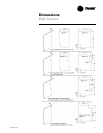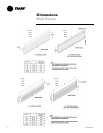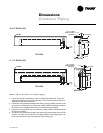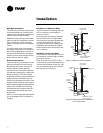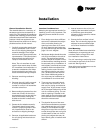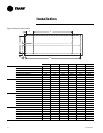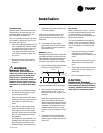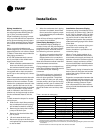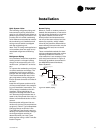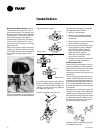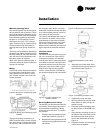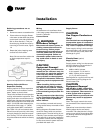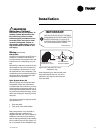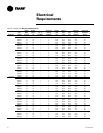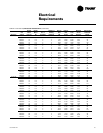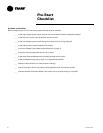
UV-SVN03D-EN 19
Split System Units
The following refrigerant piping and
interconnecting wiring instructions
apply to unit ventilators with direct ex
-
pansion type cooling coils used in con-
junction with air-cooled condensing
units. Reference must also be made to
the condensing unit installation and
wiring manuals which are shipped
with the condensing unit.
Note: The ETL listing mark applied to a
unit ventilator does not apply to any
associated refrigerant condensing
unit.
Refrigerant Piping
Unit ventilators with direct expansion
cooling contain a nitrogen holding
charge in the evaporator coils. Con
-
nections are ‘‘pinched-off’’ at the fac-
tory.
To connect the condensing unit lines,
cut off the stubouts and swage. The
condensing unit lines can then be
brought into the swage and brazed.
Trane recommends the use of nitro
-
gen purge when brazing refrigerant
lines to prevent formation of oxides in
the lines.
Install the refrigerant suction and liq-
uid lines as described in the condens-
ing unit installation instructions. The
TXV is factory installed on the Unit
Ventilator. Piping should be run
straight out through the back of the
unit. Access piping knockouts are lo
-
cated in the rear panels of the unit, as
shown in dimensional section of this
manual.
Recommended refrigerant line con-
nections for various unit combinations
are given in Table 7. Typical Superheat
Charging Charts are shown in the
Trane Service Facts found in the con
-
densing unit section manual. Refriger-
ant charge weights can also be
determined with your local Trane
sales engineer using a valid Trane Se
-
lection Program.
Steam Piping
When air, water or another product is
heated, the temperature or heat trans-
fer rate can be regulated by a modulat-
ing steam pressure control valve.
Since pressure and temperature do
not vary at the same rate as load, the
steam trap capacity, which is deter
-
mined by the pressure differential be-
tween the trap inlet and outlet, may be
adequate at full load, but not some
lesser load.
There are detailed methods for deter-
mining condensate load under various
operating conditions. However, in
most cases this is not necessary if the
coils are piped as shown in Figure 5.
Follow the procedure documented in
the ASHRAE Systems Handbook,
Steam Systems.
Figure 5: Steam piping
Vacuum Equalizer
H= 12"
minimum
F&T Trap
See text for sizing
Gravity flow to
vented receiver
Coil
To Condensate
return
Temp. Regulating Valve
Installation



